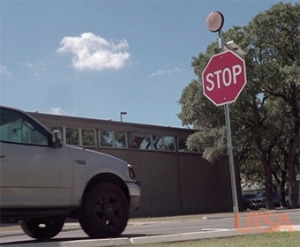Mar 7 2019
On a dark backroad, a motorist speeds toward the intersection. A little ahead, the stop sign blends with the night and within seconds a fatal crash takes place. According to the U.S. Department of Transportation, over half of all roadway fatal accidents happen on rural roads. Currently, engineers at The University of Texas at San Antonio (UTSA) are constructing and testing a low-cost, self-powered thermal system that will spot vehicles, enhance the visibility of stop signs, and help avoid fatalities.
 (Image credit: The University of Texas at San Antonio (UTSA)
(Image credit: The University of Texas at San Antonio (UTSA)
“Stop signs on rural roads are difficult to notice, and this leads to dangerous accidents,” said Ayetullah Biten, a doctoral candidate in the UTSA Department of Electrical and Computer Engineering.
According to the Federal Highway Administration, rural roads make up for 70% of the country’s byways and the location for 54% of all mortalities. With a power supply not accessible, they are more probable than other roads to not have signals and active traffic signage.
To enhance the safety of a driver, Sara Ahmed and Samer Dessouky, professors in the UTSA College of Engineering, have developed an economical, self-powered intersection detection and warning system to warn rural motorists about possible risks. The next-generation stop sign employs a multi-pixel passive infrared sensor that spots a vehicle as it approaches an intersection. Once the vehicle is close to the sensing range, a signal beacon activates the flashing system of the stop sign.
The sensor observes thermal signatures and processes them to detect passing vehicles. It distinguishes the vehicle’s direction of travel, estimates the velocity of its thermal signature and determines the classification of the vehicle.
Zachary Balcar, Master’s Student, Department of Electrical and Computer Engineering, UTSA.
Generally, the smart system delivers a 90% vehicle detection rate and a vehicle classification accuracy of 72%. Compared to existing traffic sensing technologies in urban areas such as video image processors, magnetic loop inductors, and microwave radar, the new system guzzles less power and provides improved accuracy. The new technology is also a lot less expensive to create. Present-day safety systems can cost nearly $5,000, while the UTSA’s detection promises to be a fraction of the cost at $60 to $100 per system.
Our off-roadway system can be installed on urban or rural roads completely independent of the utility power grid, because it is powered by small solar panels and functions in all weather conditions.
Sara Ahmed, Professor, College of Engineering, UTSA.
The low-power rural intersection detection and warning system was created with assistance from the Connect program, a cooperative research program that is co-sponsored by UTSA and Southwest Research Institute.
The researchers have filed an invention disclosure for the system, which was recently acknowledged nationwide by the American Road and Transportation Builders Association, and plans to adapt the technology to pedestrian detection, for vehicle-to-infrastructure communication, and for border security.
Rural Area Vehicle Detection
(Video credit: The University of Texas at San Antonio (UTSA))